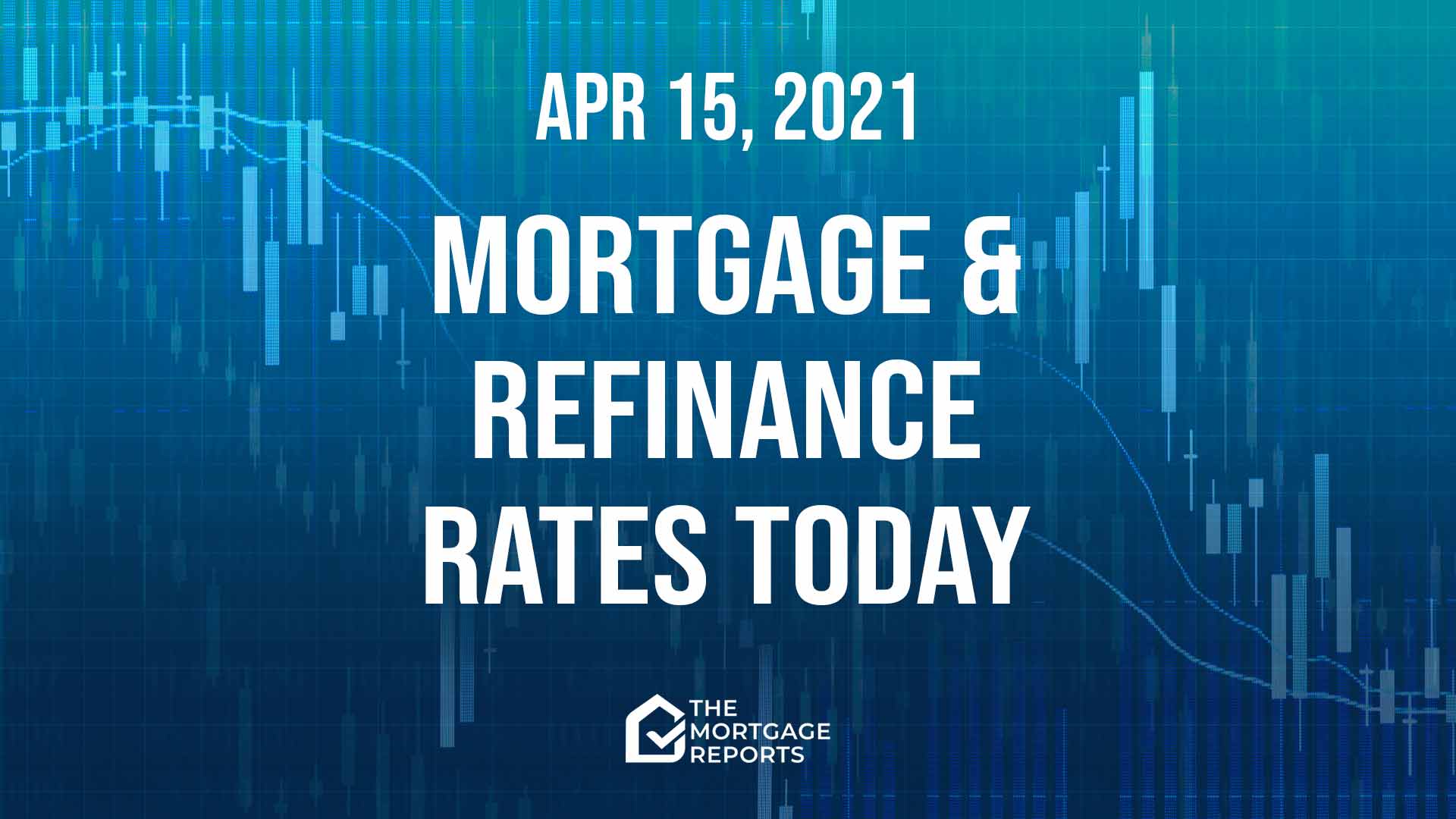
Today’s mortgage and refinance rates
Average mortgage rates edged lower yet again yesterday. Each fall is small. But they’re beginning to add up.
And they may get better yet. In spite of this morning’s better-than-expected retail sales and weekly unemployment numbers, mortgage rates today look likely to fall again.
Find and lock a low rate (Apr 15th, 2021)Current mortgage and refinance rates
| Program | Mortgage Rate | APR* | Change |
|---|---|---|---|
| Conventional 30 year fixed | |||
| Conventional 30 year fixed | 3.034% | 3.039% | +0.03% |
| Conventional 15 year fixed | |||
| Conventional 15 year fixed | 2.281% | 2.399% | -0.09% |
| Conventional 20 year fixed | |||
| Conventional 20 year fixed | 2.813% | 2.904% | -0.06% |
| Conventional 10 year fixed | |||
| Conventional 10 year fixed | 1.842% | 2.062% | -0.02% |
| 30 year fixed FHA | |||
| 30 year fixed FHA | 2.773% | 3.43% | +0.02% |
| 15 year fixed FHA | |||
| 15 year fixed FHA | 2.591% | 3.177% | -0.03% |
| 5 year ARM FHA | |||
| 5 year ARM FHA | 2.5% | 3.201% | Unchanged |
| 30 year fixed VA | |||
| 30 year fixed VA | 2.375% | 2.547% | Unchanged |
| 15 year fixed VA | |||
| 15 year fixed VA | 2.25% | 2.571% | Unchanged |
| 5 year ARM VA | |||
| 5 year ARM VA | 2.5% | 2.379% | Unchanged |
| Rates are provided by our partner network, and may not reflect the market. Your rate might be different. Click here for a personalized rate quote. See our rate assumptions here. | |||
COVID-19 mortgage updates: Mortgage lenders are changing rates and rules due to COVID-19. To see the latest on how coronavirus could impact your home loan, click here.
Should you lock a mortgage rate today?
My recommendations (below) say you should lock your mortgage rate wherever you are in the homebuying process. But don’t feel you must while rates are falling or holding steady — as they have been so far in April.
However, if you do delay, please do two things. First, talk to your lender to be sure you’re going to be able to lock quickly when you need to. And, secondly, keep an eagle eye on mortgage rate movements. It’s always possible that rates could rise sharply, if and when there’s a change in direction.
Still, for now, my personal rate lock recommendations remain:
- LOCK if closing in 7 days
- LOCK if closing in 15 days
- LOCK if closing in 30 days
- LOCK if closing in 45 days
- LOCK if closing in 60 days
But I don’t claim perfect foresight. And your personal analysis could turn out to be as good as mine — or better. So you might choose to be guided by your instincts and your personal tolerance for risk.
Market data affecting today’s mortgage rates
Here’s a snapshot of the state of play this morning at about 9:50 a.m. (ET). The data, compared with roughly the same time yesterday, were:
- The yield on 10-year Treasurys fell to 1.58% from 1.64% (Good for mortgage rates.) More than any other market, mortgage rates normally tend to follow these particular Treasury bond yields, though less so recently
- Major stock indexes were higher on opening. (Bad for mortgage rates.) When investors are buying shares they’re often selling bonds, which pushes prices of those down and increases yields and mortgage rates. The opposite happens when indexes are lower
- Oil prices climbed to $62.71 from $61.35 a barrel. (Bad for mortgage rates*.) Energy prices play a large role in creating inflation and also point to future economic activity.)
- Gold prices rose to $1,755 from $1,738 an ounce. (Neutral for mortgage rates*.) In general, it’s better for rates when gold rises, and worse when gold falls. Gold tends to rise when investors worry about the economy. And worried investors tend to push rates lower
- CNN Business Fear & Greed index — Inched down to 53 from 54 out of 100. (Good for mortgage rates.) “Greedy” investors push bond prices down (and interest rates up) as they leave the bond market and move into stocks, while “fearful” investors do the opposite. So lower readings are better than higher ones
Caveats about markets and rates
Before the pandemic and the Federal Reserve’s interventions in the mortgage market, you could look at the above figures and make a pretty good guess about what would happen to mortgage rates that day. But that’s no longer the case. We still make daily calls. And are usually right. But our record for accuracy won’t achieve its former high levels until things settle down.
So use markets only as a rough guide. Because they have to be exceptionally strong or weak to rely on them. But, with that caveat, so far mortgage rates today look likely to fall. Just be aware that intraday swings (when rates change direction during the day) are a common feature right now.
Find and lock a low rate (Apr 15th, 2021)
Important notes on today’s mortgage rates
Here are some things you need to know:
- Typically, mortgage rates go up when the economy’s doing well and down when it’s in trouble. But there are exceptions. Read ‘How mortgage rates are determined and why you should care‘
- Only “top-tier” borrowers (with stellar credit scores, big down payments and very healthy finances) get the ultralow mortgage rates you’ll see advertised
- Lenders vary. Yours may or may not follow the crowd when it comes to daily rate movements — though they all usually follow the wider trend over time
- When daily rate changes are small, some lenders will adjust closing costs and leave their rate cards the same
- Refinance rates are typically close to those for purchases. But some types of refinances are higher following a regulatory change
So there’s a lot going on here. And nobody can claim to know with certainty what’s going to happen to mortgage rates in coming hours, days, weeks, or months.
Are mortgage and refinance rates rising or falling?
Today and soon
As you may know, I’m convinced that mortgage rates will begin to rise again soon. That’s not a fiendishly clever analysis. It’s just that almost all economists are forecasting a boom. And thriving economies pretty much invariably bring higher interest rates.
But why have mortgage rates been falling this month? Scanning the financial press, nobody seems sure.
However, a week ago, MarketWatch suggested that US Treasury bond markets (with which mortgage rates are usually closely associated) may be correcting themselves. They’d been trading on the basis that the Federal Reserve would have to raise interest rates and taper asset purchases sooner than it had previously forecast. But now they believed its repeated protestations that it won’t.
And other drivers of lower rates might be in play. For example, some investors may be worried that concerns over certain vaccines might delay the economic recovery. And rising COVID-19 infection rates might also contribute. The change in new cases was +11% over the last two weeks, according to today’s New York Times. But new deaths were down 19%, perhaps thanks to the so-far impressive vaccine rollout.
Even added together, April’s falls in mortgage rates have been modest. So perhaps those are good enough explanations.
Either way, don’t necessarily expect these good times to keep on rolling for much longer. That MarketWatch article ended by quoting Padhraic Garvey, regional head of research for Americas at ING, who said he “still saw the path of yields as heading higher.” And higher bond yields mean higher mortgage rates
For more background on my wider thinking, read our latest weekend edition, which is published every Saturday soon after 10 a.m. (ET).
Recently
Over much of 2020, the overall trend for mortgage rates was clearly downward. And a new, weekly all-time low was set on 16 occasions last year, according to Freddie Mac.
The most recent weekly record low occurred on Jan. 7, when it stood at 2.65% for 30-year fixed-rate mortgages. But then the trend reversed and rates rose.
However, Freddie’s Apr. 8 report puts that weekly average at 3.13% (with 0.7 fees and points), down from the previous week’s 3.18%. In a news release, Freddie noted, “After moving up for seven consecutive weeks, mortgage rates have dropped due to the recent, modest decline of U.S. Treasury yields.”
Expert mortgage rate forecasts
Looking further ahead, Fannie Mae, Freddie Mac and the Mortgage Bankers Association (MBA) each has a team of economists dedicated to monitoring and forecasting what will happen to the economy, the housing sector and mortgage rates.
And here are their current rates forecasts for the remaining quarters of 2021 (Q2/21, Q3/21, Q4/21) and the first quarter of 2022 (Q1/22).
The numbers in the table below are for 30-year, fixed-rate mortgages. Freddie’s were updated on April 14, Fannie’s on March 17 and the MBA’s on March 22.
| Forecaster | Q2/21 | Q3/21 | Q4/21 | Q1/22 |
| Fannie Mae | 3.1% | 3.1% | 3.2% | 3.3% |
| Freddie Mac | 3.2% | 3.3% | 3.4% | 3.5% |
| MBA | 3.2% | 3.4% | 3.6% | 3.7% |
However, given so many unknowables, the current crop of forecasts might be even more speculative than usual. And there’s certainly a widening spread as the year progresses.
Find your lowest rate today
Some lenders have been spooked by the pandemic. And they’re restricting their offerings to just the most vanilla-flavored mortgages and refinances.
But others remain brave. And you can still probably find the cash-out refinance, investment mortgage or jumbo loan you want. You just have to shop around more widely.
But, of course, you should be comparison shopping widely, no matter what sort of mortgage you want. As federal regulator the Consumer Financial Protection Bureau says:
Verify your new rate (Apr 15th, 2021)Shopping around for your mortgage has the potential to lead to real savings. It may not sound like much, but saving even a quarter of a point in interest on your mortgage saves you thousands of dollars over the life of your loan.



